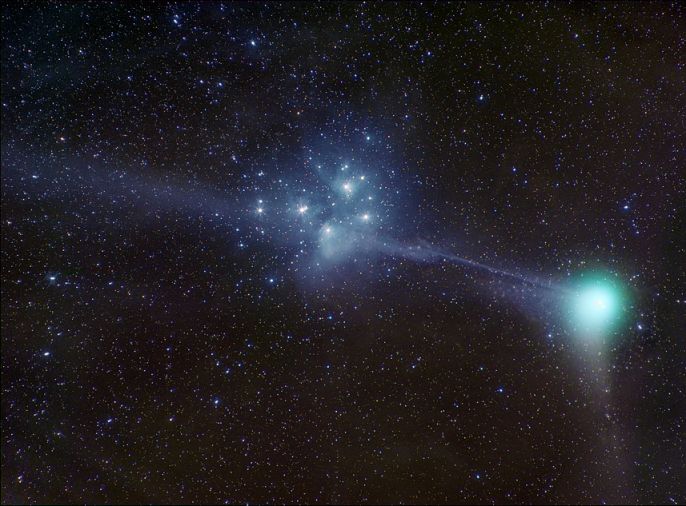
|
Credit & Copyright: Stefan Seip
Explanation:
Sweeping northward in planet Earth's sky,
comet Machholz
extended its long ion tail with the
Pleiades star cluster
in the background on January 7th.
This stunning view,
recorded with a telephoto lens in
skies over Oberjoch, Bavaria, Germany, emphasizes faint,
complex tail
structures and the scene's lovely blue
and green colors.
Merging with the blue dust-reflected starlight of the Pleiades,
colors in the comet's
ion tail and greenish coma are
produced as gas molecules
fluoresce in sunlight.
Reflecting the sunlight, dust from
comet Machholz trails
along the comet's
orbit
and forms the whitish tail jutting
down and toward the right.
While the visible
coma
spans about 500,000 kilometers,
the nucleus of the comet, likely only a few kilometers
across, lies hidden within.
Comet tails can extend
many millions of kilometers
from the nucleus, but appear substantially shortened
because of perspective.
|
January February March April May June July August September October November December |
| |||||||||||||||||||||||||||||||||||||||||||||||||||||||
NASA Web Site Statements, Warnings, and Disclaimers
NASA Official: Jay Norris. Specific rights apply.
A service of: LHEA at NASA / GSFC
& Michigan Tech. U.
Based on Astronomy Picture
Of the Day
Publications with keywords: Comet Machholz - pleiades - comet - star cluster - comet tail - M 45
Publications with words: Comet Machholz - pleiades - comet - star cluster - comet tail - M 45
See also:
- APOD: 2025 December 1 Á 3I ATLAS: Tails of an Interstellar Comet
- APOD: 2025 November 25 Á Comet Lemmon and the Milky Way
- 3I/ATLAS: A View from Planet Earth
- APOD: 2025 November 17 Á Comet Lemmons Wandering Tail
- APOD: 2025 September 30 Á Comet Lemmon Brightens
- APOD: 2025 September 29 Á Two Camera Comets in One Sky
- APOD: 2025 September 26 Á A SWAN an ATLAS and Mars
